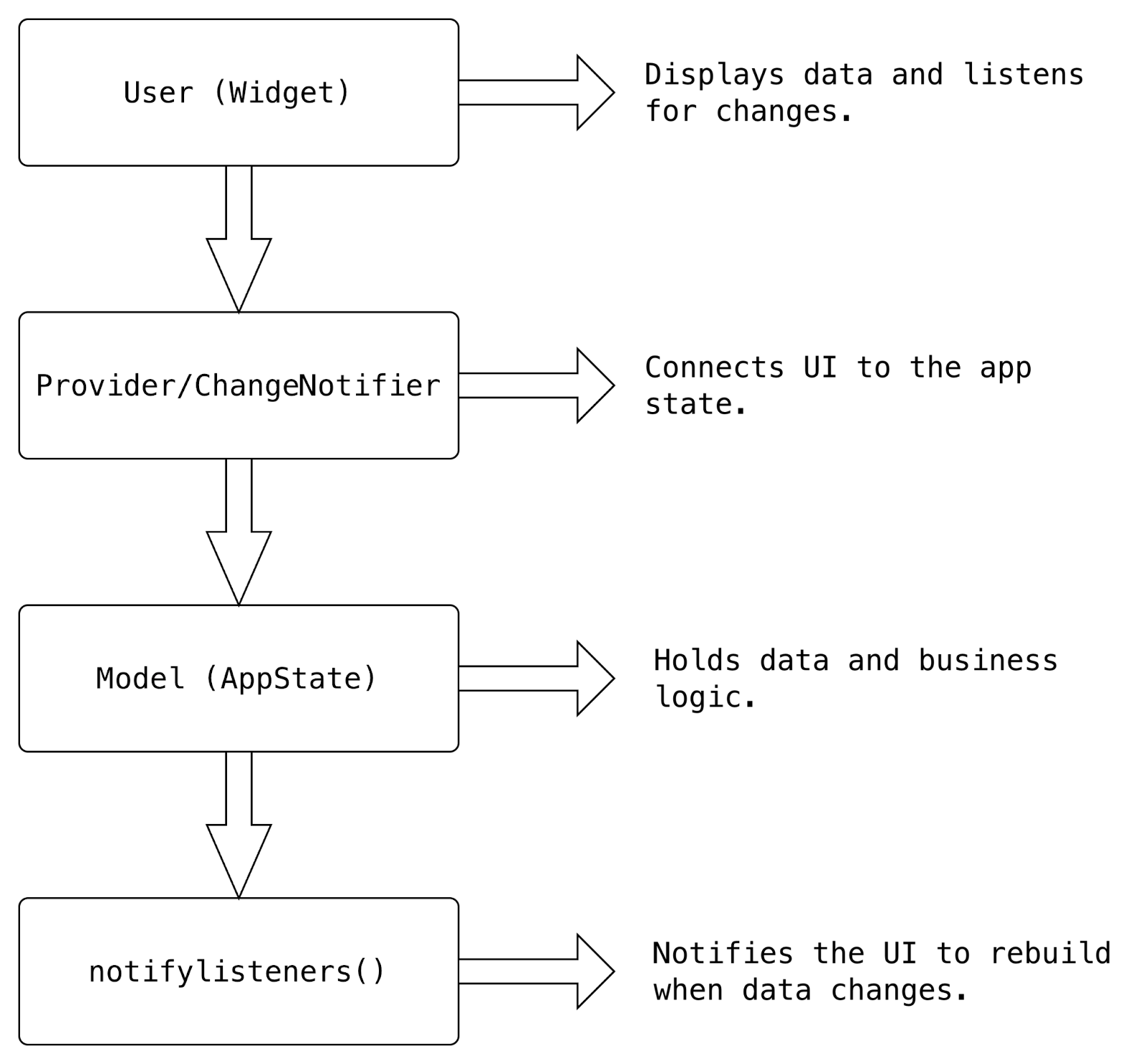
Jay
Jay is a mobile and full-stack developer passionate about building scalable Flutter applications and modern backend systems with Node.js and MongoDB. He enjoys simplifying complex technical concepts and helping developers understand architecture, performance, and clean code practices.
Article by Gigson Expert
State management is at the heart of every Flutter application. Whether you’re building a small personal project or a complex enterprise app, managing your app’s state efficiently determines how maintainable, scalable, and testable your codebase will be.
In this article, we’ll break down three of the most popular state management approaches in Flutter (Provider, Riverpod, and BLoC), exploring their strengths, weaknesses, and when to use each.
What is State Management in Flutter?
State management refers to how your app handles and responds to data changes. In Flutter, this includes;
- UI state (e.g, a radio button being selected)
- Application state (e.g, user authentication, theme mode, toggling buttons)
- Data state (e.g, API responses, database values, Network states)
Flutter offers multiple solutions for managing state, from basic setState((){}) to complex architectures like BLoC and Riverpod. The right choice depends on your app’s complexity, team size, and maintainability goals.
Provider: The Classic Choice
Provider is one of Flutter’s first officially endorsed state management libraries, built by Remi Rousselet. It’s simple, efficient, and great for small to medium projects.
Key Concepts
- Uses
ChangeNotifierfor reactive updates. - Inherits context-based dependency injection.
- Works well for simple reactive UIs.
Advantages of using Providers
- Simple to learn and widely used
- Built into the Flutter ecosystem
- Great for small apps or beginners
Disadvantages of using Providers
- Context dependency can be confusing (
context.read,context.watch) - Boilerplate for larger apps
- Not easily testable due to context coupling
How Provider Data Flows

Example
// Defines a ChangeNotifier class that holds state and notifies listeners of changes
class Counter extends ChangeNotifier {
// The state variable that stores the counter value
int count = 0;
// A method to increment the counter value
void increment() {
count++; // Increase count by 1
notifyListeners(); // Notify all listening widgets to rebuild
}
}
// Access the Counter provider and listen for changes
final counter = context.watch<Counter>();
// Display the current counter value in a Text widget
Text('${counter.count}');Riverpod: The Modern Successor
Riverpod, also created by Remi Rousselet, was designed to overcome Provider’s limitations. It’s type-safe, testable, and doesn’t depend on BuildContext.
Key Concepts
- Providers are declared globally.
- Works without BuildContext.
- Supports asynchronous state (
FutureProvider,StreamProvider). - Has hooks (
flutter_hooks) and code generation (riverpod_generator).
Advantages of using Riverpod
- Context-free, easier testing and reuse
- Compile-time safety
- Powerful auto-dispose and ref.watch system
- Ideal for both small and large-scale projects
Disadvantages of using Riverpod
- Slightly steeper learning curve
- More boilerplate for simple apps
How Riverpod Data Flows

Example
// Create a StateProvider that holds an integer state, //initialized to 0
final counterProvider = StateProvider<int>((ref) => 0);
// Define a widget that listens to provider changes using ConsumerWidget
class CounterWidget extends ConsumerWidget {
@override
Widget build(BuildContext context, WidgetRef ref) {
// Watch the counterProvider -- rebuilds the widget whenever the state changes
final count = ref.watch(counterProvider);
return Column(
children: [
// Display the current counter value
Text('$count'),
// Button that increments the counter when pressed
ElevatedButton(
onPressed: () => ref.read(counterProvider.notifier).state++,
// ref.read() gets the provider without listening to changes
// .notifier gives access to the StateController to modify the state
child: Text('Increment'),
),
],
);
}
}BLoC: The Enterprise Approach
BLoC (Business Logic Component) is an architectural pattern popularized by Google. It focuses on separating UI from business logic using Streams and Events.
Key Concepts
- Uses
StreamsandSinksfor reactivity. - Business logic lives in separate “bloc” classes.
- Works well in large apps with complex logic.
Advantages of using BLoC
- Highly testable and scalable
- Excellent separation of concerns
- Great for teams and large apps
Disadvantages of using Bloc
- Verbose for small apps
- Learning curve with Streams and events
- Overkill for a simple state
How BLoC Data Flows

Example
// Define a simple BLoC (Business Logic Component) to manage counter state
class CounterBloc {
// StreamController to handle broadcasting integer states to listeners
final _counterController = StreamController<int>();
// Internal counter state
int _count = 0;
// Expose the stream for the UI to listen to
Stream<int> get countStream => _counterController.stream;
// Method to increment the counter
void increment() {
_count++; // Update internal counter
_counterController.sink.add(_count); // Emit new counter value to the stream
}
// Dispose method to close the stream when BLoC is no longer needed
void dispose() {
_counterController.close(); // Release resources to prevent memory leaks
}
}Comparison Table

Which Should You Choose?
- For beginner or small app projects, go with Provider for simplicity.
- For a scalable app or modern approach, choose Riverpod for flexibility and testability.
- For enterprise or team projects, use BLoC for strict architecture and maintainability.
Modern Relevance Update
Since Flutter 3.x and Dart 3, state management has gained new language and framework features. Riverpod and BLoC now benefit from Dart’s pattern matching and sealed classes, making state handling more robust and readable.
Riverpod 2.x highlights: autoDispose for automatic cleanup, provider_scopes for more granular control, and AsyncNotifier for simpler asynchronous state management.
Conclusion
There’s no single “best” state management solution in Flutter, only the one that best fits your app’s complexity and your team’s workflow.
If you’re starting a new project today, Riverpod offers the best balance between power and simplicity. Understanding all three —Provider, Riverpod, and BLoC — will make you a more versatile Flutter developer.
FAQs
Can I mix Provider, Riverpod, and BLoC in one project?
Yes, though it’s best to standardise. Mixing is fine for gradual migration or isolated modules.
Which state management solution performs best?
All three perform well. The choice mostly affects scalability, not performance.
Is Riverpod production-ready?
Absolutely. Riverpod 2.x is stable, actively maintained, and used in production by many teams.





.webp)
